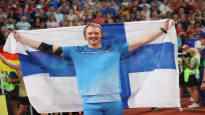The Finnish athletes who celebrated medals at the European Championships in Munich competed at their absolute top level. Next up is the increase in the basic level, writes journalist Atte Husu.
In April 2015 Lassi Etelätalo the sports surgeon could hardly guess what kind of rumba he would have sitting in front of him Harri Heliön at the reception in Helsinki. The reason for the visit was the elbow of the throwing arm that caused pain, from which Heliö polished the cartilage and bone.
Etelätalo had come to the attention of Finnish athletics people in a big way the previous summer: the first ranking competition of his career at the European Championships in Zurich had produced fourth place, which had been preceded by the record 84.98 seen in Joensuu.
In the history books, 22 javelin men have been able to throw more than 90 meters. Their average age at the time of the record has been 26 years. Getting into the prestigious club was definitely also Etelätalo’s goal when he went to show his elbow to Heliö for the first time – at the age of 26.
However, Ruoholahti’s reception became frustratingly familiar during the next 16 months, as Etelätalo’s elbow had to be opened twice more.
The next 80-meter javelin result was seen by Etelätalo in Virroi on June 6, 2019. Joensuu Kataja’s thrower was 31 years old at the time.
Etelätalo therefore spent his best years as a javelin thrower under the knife and in rehabilitation following surgeries. Surviving this mangle took some brains.
Pressure-polished diamond
Etelätalo’s medical history listed above has already been told several times, because Etelätalo has been a guard a lot in Finnish javelin throwing in recent years. In general, the formula of the javelin summer has been the following: at the beginning, the focus is on the 90-meter mark Oliver in Helander, but as the summer progresses, the radar turns to Etelätalo. This happens at the latest in value competitions.
Starting with the 1912 Stockholm Olympics, at least one Finnish male javelin thrower has participated in all the senior finals when Finnish general athletes have participated in the Games – only the 1956 Melbourne Olympics did not. Without Etelätalo, the tradition would have died at the 2019 World Cup in Doha, at the age of 107.
Etelätalo has made it to the competition team five times and has always reached the points. Of those who traveled to Munich, only the sports coach Tero in Pitkämäki has a longer streak: at least points, certainly four medals, in the first seven competitions of his adult career.
The 34-year-old Etelätalo’s five race trips are put in an even better light when the results seen in them are taken into account and compared to the previous level of the season.
In the 2014 EC final, he threw his second best result of the season. The same thing happened in the 2019 World Cup final. Last year, in the qualification for the Tokyo Olympics, he achieved his best result of the season, which is described by the letter combination SB, which was also added to the result of Etelätalo a month ago at the World Championships in Oregon.
When you add the record that brought bronze at the European Championship in Munich on Sunday night, Etelätalo’s ability to get the best out of itself in the tightest place is unparalleled.
If Etelätalo’s competitive gifts were a product that could be bought, the Sports Confederation – and many other sports associations – would surely be ready to dig up the picture.
Even one World Cup medal would be a great achievement
The Finnish team’s medal haul from the European Championships in Munich was two gold, silver and bronze. The last time the medal haul in prestigious outdoor track competitions was better was at the Montreal Olympics in 1976. In addition to the medals, Munich got five other points, i.e. placings in the top eight.
As the table below shows, the Finnish athletes competed in the EC arena with a major victory compared to their level.
The team had only three athletes who were among the top three in their sport’s best statistics of the season when they reached Munich. Kristiina Mäkelän the statistical position also materialized into a worthy medal. There were no other top 6 statistical athletes. Considering the starting level, the team’s result of four medals is, to put it mildly, astonishing.
For the majority of the Finnish team, a southern house-like performance would not have been enough for the finals, let alone for the points. When looking at the state of domestic athletics, the EC level is the best possible platform for it. At next year’s World Championships in Budapest, even one Finnish medal is a tough achievement. The previous World Cup medal is Pitkämäki’s bronze from Beijing in 2015.
A fact about Pitkämäki worth keeping in mind
In value competitions, success is achieved especially with a strong basic level. Records are extremely rare. So were they in Munich.
When long running distances, walks and relays are excluded from the calculations, fifteen of the 102 medal results of the European Championships are decorated with the letter combination PB, which describes a personal record, in the list of results.
Finland was an exception at the Munich Games: no less than three of the four medals came with a record.
Achieving Olympic and World Cup medals requires Finland’s athletics elite to strengthen the basic level in particular. A model example of a solid level of results is Pitkämäki, whose 16 career races did not produce any records or even a single season’s best. Still, the balance was seven medals.
Finnish athletics has managed to turn its course, but after the sensational EC success in Munich, it is necessary to keep the feet firmly on the ground. In any case, the prospect is tantalizing when talking about the next European Championships to be held in Rome in 2024.
